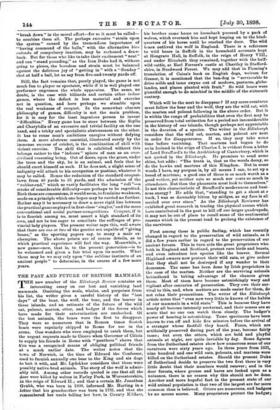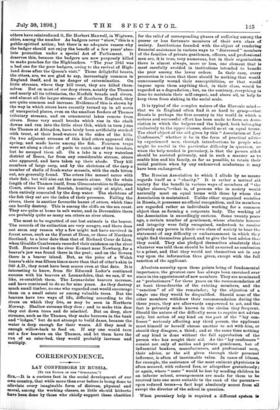THE PAST AND FUTURE OF BRITISH MAMMALS.
THE new number of the Edinburgh Review contains an interesting essay on our lost and vanishing land mammals. Omitting the seals, whales, and porpoises from his list, the writer gives a careful history of the "last days" of the bear, the wolf, the boar, and the beaver in these islands, and an estimate of the future of the wild cat, polecat, marten, otter, and badger if the forces which have made for their extermination are unchecked. Of the lost animals, the bears were the first to disappear. They were so numerous that in Roman times Scotch bears were regularly shipped to Rome for use in the arena. One wonders who were employed to catch them, but the urgent requests made to Cicero when Governor of Cilicia to supply his friends in Rome with " panthers " shows that .this was a recognised means of obliging political friends -at a much earlier date. The writer notes that the town of Norwich, in the time of Edward the Confessor, used to furnish annually one bear to the King and six dogs to bait it with, and Mr. Lydekker considers that these were possibly native-bred animals. The story of the wolf is admir- ably told. Among other records quoted is one that all the deer were killed by wolves in Farley Park, in Worcestershire, in the reign of Edward II.; and that a certain Mr. Jonathan Grubb, who was born in 1808. informed Mr. Harting in a ,letter that his grandmother was born in 1731, and that she remembered her uncle telling her how, in County Kildare,
his brother came home on horseback pursued by a pack of wolves, which overtook him and kept leaping on to the hind- quarters of his horse until he reached the door. The wild boars outlived the wolf in England. There is a reference to wild boars in Suffolk in the household accounts kept at Hengrave Hall, in Suffolk, in the reign of Henry
and under Elizabeth they remained, together with the half- wild cattle, at Earl Ferrers's castle at Chartley in Stafford- shire, in Needwood Forest. We may add that in Fleming's translation of Cains's book on English dogs, written for Gesner, it is mentioned that the ban-dog is " serviceable to drive Wilde and tame swyne out of medows, pastures, glebe- landes, and places planted with fruit." So wild boars were plentiful enough to do mischief in the middle of the sixteenth century.
Which will be the next to disappear P If any more creatures must follow the bear and the wolf, they are the wild cat, with the marten and polecat following in the above order. Bat it is within the range of probabilities that even the first may be preserved from total extinction for a period not inconsiderable in the history of our islands, though perhaps not appreciable in the duration of a species. The writer in the Edinburgh considers that the wild cat, marten, and polecat are next in order for disappearance. If so, they may take some time before vanishing. That martens had begun to do so in Ireland in the reign of Charles I. is evident from a letter of Lord Strafford's to the Archbishop of Canterbury, which is not quoted in the Edinburgh. He promises to send some skins, but adds: "The truth is, that as the woods decay, so do the hawks and martens of this Kingdom. But in some woods I have, my purpose is, by all means I can, to set up a breed of martens; a good one of these is as much worth as a good wether, yet neither eats so much nor costs so much in attendance. But then the pheasants must look to themselves." Is not this characteristic of Strafford's modernness and busi- ness energy ? He adds that, " standing to get a shoot at e buck, I was so damnably bitten by midges, as my face is all mezled over ever since." As the Edinburgh Reviewer has exhibited great research in tracing the physical causes which have contributed in the past to kill off our larger quadrupeds, it may not be out of place to recall some of the sentimental reasons which in the present tend to prolong the existence of the survivors.
First among these is public feeling, which has recently changed in regard to the preservation of wild animals, as it did a few years earlier in regard to the preservation of oar ancient forests. This in turn aids the great proprietors who. both in England and Scotland, protect rare birds and beasts, and even introduce lost species like the beaver. Several Highland owners now protect their wild cats, or give orders that they shall not be destroyed if any wander to their demesnes. The same has been done by Irish proprietors in the case of the marten. Neither are the surviving animals behindhand in taking advantage of the chances given them. Most of them have become astonishingly wary and vigilant after centuries of persecution. They owe their sur- vival to this, and, when matters are made easier for them, do not relax their precautions. The writer of the Edinburgh article notes that " even now very little is known of the habits of our mammals in a wild state." This is because they have nearly all become intensely nocturnal, and their senses are so acute that no one can watch them closely. The badger's power of hearing is astonishing. Tame specimens have been known to ran off and hide five minutes before the arrival of a stranger whose footfall they heard. Foxes, which are artificially preserved during part of the year, become fairly tame; but even the otters, which are bold and playful animals at night, are quite invisible by day. Some figures from the Sutherland estates show how numerous some of our carnivore were sixty years ago. In three years from 1831, nine hundred and one wild cats, polecats, and martens were killed on the Sutherland estates. Should the present Duke of Sutherland decide to preserve the two first there is very little doubt that their numbers would recover ; and in the deer forests, where grouse and hares are looked upon as a nuisance, there is no reason why this should not be done. Another and more hopeful fact in the present state of our wild animal population is that two of the largest are far more common than is believed. Otters are numerous, and badgers by no means scarce. Many proprietors protect the badger; others have reintroduced it, Sir Herbert Maxwell, in Wigtown_ ehire, among the number As badgers never " show," this is a public-spirited action; but there is no adequate reason why the badger should not enjoy the benefit of a few years' abso- lute protection under a special Act of Parliament. It deserves this, because the badgers are now purposely killed to make pouches for the Highlanders. " The year 1842 was a bad one for the poor badgers, owing to the revival of High- land dress after the Queen's visit." Those delightful beasts, the otters, are, we are glad to say, increasingly common in England itself, and in no danger of extermination. On little streams, where they kill trout, they are killed them- selves. But on most of our deep rivers, notably the Thames and nearly all its tributaries, the Norfolk broads and rivers, and almost all the larger streams of Southern England, they are quite common and increase. Evidence of this is shown by the way in which otters have recently turned up in all sorts of unexpected places, even on the smallest feeders of Thames tributary streams, and on ornamental lakes remote from rivers. Some very small brooks which rise in the chalk downs and run into the little river Ock, which in turn joins the Thames at Abingdon, have lately been artificially stocked with trout, at their head-waters in the sides of the hills. On two adjacent streams of this kind otters appeared this spring, and made havoc among the fish. Fourteen traps were set along a chain of pools to catch one of the invaders, but he escaped them all. On a lake in a very waterless district of Essex, far from any considerable stream, otters also appeared, and have taken up their abode. They kill numbers of large carp, and by the skeletons of the carp a number of shells of fresh-water mussels, with the ends bitten out, are generally found. The otters like mussel sauce with their fish; but will also eat the mussels alone. On the whole length of the Thames itself, from Gloucestershire to Hampton Court, otters live and flourish, hunting only at night, and then entirely concealed by the deep water. The skeletons of the fish they eat• are the index of their presence. Failing the rivers, there is another favourite haunt of otters, which time can hardly destroy. This is among the cliffs on the sea coast. They are quite at home in salt water, and in Devonshire there are probably quite as many sea otters as river otters.
The most to be regretted of our lost animals is the beaver. The records of its extinction are very meagre, and there does not seem any reason why a few might not have survived in forest areas, such as the Forest of Dean, or those of Northern Scotland, to a later date than that of Richard Ccear de Lion, when Giraldis Cambrensia recorded their existence on the river Teifi. Beavers lived on the river Kennet near Newbury, for a beaver's jaw was found there in the peat ; and on the Severn there is a beaver island. But, as the price of a Welsh beaver's skin was fifteen times more than that of otter's skin in 940 A.D., they must have been scarce even at that date. It is interesting to know, from Sir Edmund Loder's continued success with his beavers at Leonardslee, that we can, if we like, re-establish them. The Leonardslee beavers increase, and have continued to do so for nine years. As they destroy much small timber, no one who regarded cost would encourage them on a small estate or among valuable trees. But the beavers have two ways of life, differing according to the rivers on which they live, as may be seen in Northern Norway. Shallow streams they dam; and to make this dam they cut down trees and do mischief. But on deep, slow streams, such as the Thames, they make burrows in the bank and "lodges," but do not attempt to build dams, because the water is deep enough for their wants. All they need is enough willow-bark to feed on. If any one would turn out a few beavers on the Thames, and let them have the ran of an osier-bed, they would probably increase and multiply.



































 Previous page
Previous page